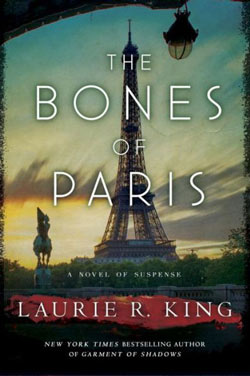 The Bones of Paris by Laurie R. King is a return for former-Bureau Agent, now private investigator Harris Stuyvesant, who'll seek a missing young woman among the notorious and artistic in Jazz Age Paris (available September 10, 2013).
The Bones of Paris by Laurie R. King is a return for former-Bureau Agent, now private investigator Harris Stuyvesant, who'll seek a missing young woman among the notorious and artistic in Jazz Age Paris (available September 10, 2013).
Laurie R. King is best known for her long-running historical mystery series featuring detective Mary Russell and her mentor Sherlock Holmes; she’s also the author of the contemporary Kate Martinelli police procedurals. King jumps forward a little in time to 1929 with The Bones of Paris, in which she returns to former U.S. Bureau of Investigation agent and detective Harris Stuyvesant, introduced in Touchstone, previously a standalone novel. Note there is a subplot including events that continue from Touchstone, but it is comprehensible even if you have not read that book.
Stuyvesant is a noir-style detective with few ties to anyone or anything; temporarily trapped in Berlin by lack of money, he eagerly takes a job to look for young Philippa Crosby, because the money and the needs of the search will get him to Paris again. The mystery grows steadily more macabre as it progresses, and Stuyvesant becomes more emotionally involved in the tragedies unfolding before him.
I loved the rich historical description throughout, which includes not only physical description, but a sense of how it would feel to be an expatriate in Paris in that time period, and how the expatriate community intersected with various artists and other interesting personalities who all flocked to the same city and, mostly, the same neighborhoods.
A dizzying panorama of rooftops: tiles and tin, brick and timber, steeples and drying laundry; centuries of chimneypots and a narrow slice of stone magnificence in the distance. Children’s voices and taxi horns competed with a tram rattle from the rue de Rennes and a neighbor’s accordion, mournfully wading through a lively tune. His nose filled with the pervasive stink of an unemptied septic tank. Summer in Paris. He went back to his seat on the side of the bed, picking up his cigarette case and lighter. The tap of the Ronson touching wood set off a convulsion in the bed. A hand emerged from the sheets, then a tangled head of brassy blonde hair, followed by blue eyes blinking in outrage.
…
This seemed to be Stuyvesant’s day for drunken women. Well, it was Paris; it was 1929. What else could he expect? Two hours after he’d taken Lulu for breakfast (there: he’d even remembered her name) Harris Stuyvesant rapped on a polished wooden door.
Coincidentally Crosby, known as Pip, had briefly been Stuyvesant’s lover a few months before, in Nice, so he has an uneasy personal connection to the case.
Pip had been February’s Lulu, one in a string of mostly blonde, mostly young women who made a man glad to be living in 1920s France. Looking back, he distinctly remembered hesitating—she’d looked about sixteen, sitting in that bar, like a snowdrop in the badlands—but in the end, he hadn’t held out for long. Young she might be, but any seduction between them had gone the other way around: Pip Crosby practically tripped him into bed, blinking her big Clara Bow eyes and asking if he knew how to make her a White Lady. Several increasingly off-color jokes later, he had established both her determination to be “fast” and her easy familiarity with the means. Pip was no virgin, not by a long shot.
Though he is cynical about women in general, Stuyvesant feels guilty enough about sleeping with a much-younger woman that he doesn’t reveal their past relationship to her family, and as he learns more about her as a person, he regrets that she might have gotten into trouble with drugs or a dangerous lover after she left him.
Crosby’s investigation begins with Pip’s former roommate, Nancy Berger, but involves an array of historical figures, including Josephine Baker, the photographer Man Ray, Ernest Hemingway, and Cole Porter. Stuyvesant finds Pip’s connections to the Théâtre du Grand-Guignol to have ominous overtones, and considered along with discoveries by French policeman Emile Doucet, it’s soon clear that Pip’s disappearance is likely not benign and is part of a larger web of murder.
If you like atmospheric and detailed historical mystery, the investigation of serial killers, or both, The Bones of Paris is a book for you.
To learn more or order a copy, visit:
opens in a new window![]() opens in a new window
opens in a new window![]() opens in a new window
opens in a new window![]()
opens in a new window![]() opens in a new window
opens in a new window![]() opens in a new window
opens in a new window![]()
Victoria Janssen is the author of three novels and numerous short stories. She also reads a lot. Follow her on Twitter: @victoriajanssen or find out more at victoriajanssen.com.
